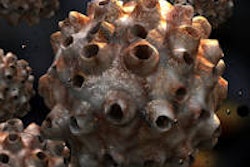
After the removal of a malignant tumor, it is natural for all parties to wonder if all the cancer cells were removed. With conventional imaging technology offering a limited view on where cancer cells may be located, often healthy tissue is removed as a precaution.
"For certain cancers, the best chance for a cure is to cut it out, but conventional preoperative imaging can't show the surgeon precisely where the cancer ends and the healthy tissue begins, so there's always an element of uncertainty," said Chadwick Wright, MD, PhD, an assistant professor of radiology at the Ohio State University College of Medicine, in a statement.
Dr. Wright is developing a hybrid imaging agent that has both the benefits of preoperative nuclear imaging, plus the ability to make cancer cells "light up" during the procedure, which may both increase the precision and reduce the anxiety of cancer surgery.
'Unusual' peptide homes in on tumor cells
Dr. Wright's imaging agent is designed around peptide HN1, which was first discovered about 15 years ago by scientists studying head and neck cancers. HN1 has been called a "head and neck cancer homing device."
 Chadwick Wright, MD, PhD. Image courtesy of Ohio State University College of Medicine.
Chadwick Wright, MD, PhD. Image courtesy of Ohio State University College of Medicine.HN1 is a hot topic because it has unusual qualities that make it seem like an ideal diagnostic and therapeutic candidate, according to Michael Tweedle, PhD, a professor and the Stefanie Spielman Chair of Cancer Imaging at Ohio State's Comprehensive Cancer Center -- Arthur G. James Cancer Hospital and Richard J. Solove Research Institute.
"Peptides can be great vehicles to deliver drugs right where you want them, but many can only carry one type of compound or are too big to target cancer cells efficiently," Tweedle said in a statement. "HN1 is unusual in that it tolerates being labeled by a large chemical and still demonstrates the ability to target cancer cells."
When viewed on a video screen through a special camera, the glowing cells provide surgeons with a real-time visual image of the cancer cells, enabling a more precise excision and confirming that the surgeon has cleared all the detectable malignant tissue.
"This type of imaging agent could go a long way to help reassure patients and surgeons," said Dr. Wright, who won a Davis Bremer pilot award from Ohio State's Center for Clinical and Translational Science to develop the agent. "Ultimately, we hope it could also help lower the risk of recurrence"
Engineering the perfect combination
Scientists are looking to combine the best features of both traditional nuclear and fluorescent optical imaging, Dr. Wright noted.
"Fluorescent dyes can fade quickly and be blocked by normal tissue but provide a real-time, detailed view. Medical radioisotopes don't give you the detail you want, but are invaluable measurement tools," said Dr. Wright, who is also part of an Ohio State research team developing a novel radioisotope-based dual probe. "An effective dual probe has to combine the best attributes of current imaging agents while leaving out undesirable traits."
Dr. Wright is using an infrared dye for fluorescence imaging during surgery and an attachable medical radioisotope that fits on the peptide for HN1's payload.
Dual probe may unlock therapeutic, technology possibilities
While HN1 has shown an affinity for other types of cancer cells, the compound is initially being developed for use in head and neck cancers, where preserving tissue is a top priority.
Dr. Wright and the research team plan to move to testing in animal models in the next year, with the goal of having a potential imaging agent available for human testing within five years.
He hopes his advancements will also help spur innovations on the imaging hardware side.
"If I'm dreaming really big, maybe someday Google Glass will be powerful enough to stream real-time images to the surgeon, or we'll have technology that can superimpose the image onto the actual surgical site," Dr. Wright noted.



















